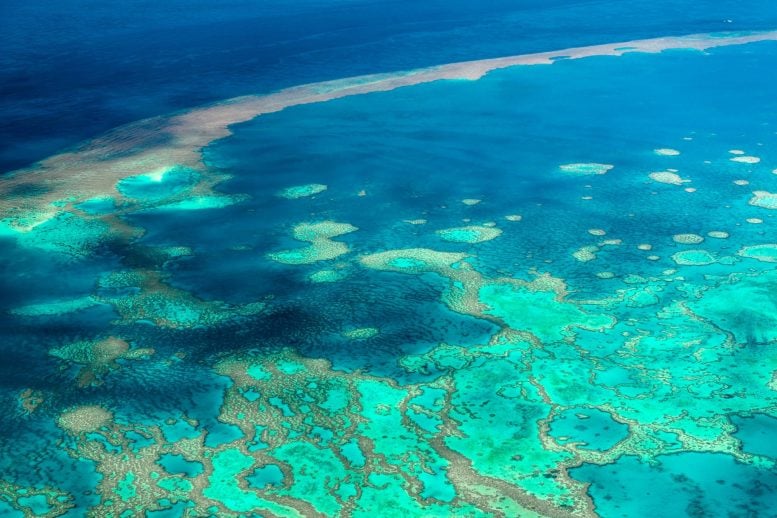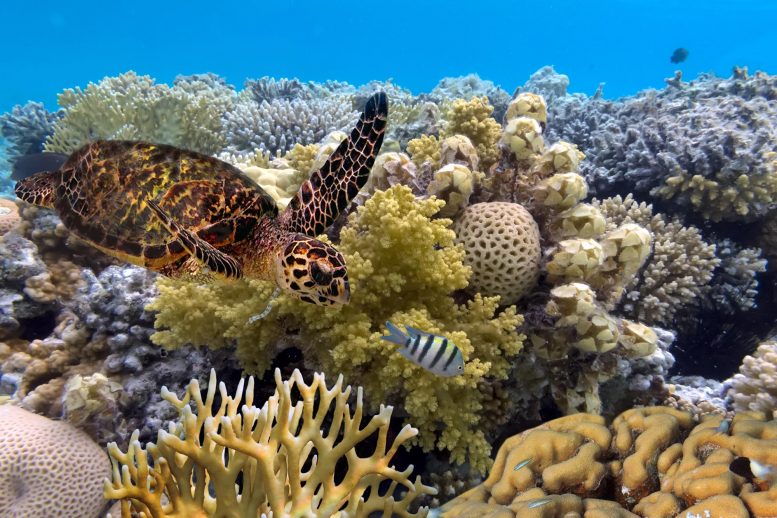
New research has shown that by injecting an alkalinizing agent into the ocean along the length of the Great Barrier Reef, it would be possible, at the present rate of anthropogenic carbon emissions, to offset ten years’ worth of ocean acidification.
The research, by CSIRO Oceans and Atmosphere, Hobart, used a high-resolution model developed for the Great Barrier Reef region to study the impact of artificial ocean alkalinization on the acidity of the waters in the Great Barrier Reef. The study is based on the use of existing shipping infrastructure to inject a source of alkalinity into the ocean, which could also be considered as an acceleration of the chemical weathering of minerals through natural processes. Their results are published today (June 8, 2021) in the IOP Publishing journal Environmental Research Letters.
The Great Barrier Reef is a globally significant coral reef system that supports productive and diverse ecosystems. At present, it is facing unprecedented stress from ocean warming, tropical cyclones, sediment and nutrient runoff, marine pests, and ocean acidification. Among these stressors, ocean acidification represents one of the most significant threats to the long-term viability of the reef, since it impacts the ability of the corals to build and repair their hard structures and recover from bleaching events.
In response to the declining health of coral reef ecosystems, a wide range of potential intervention concepts and technologies are currently under consideration, with the goal of minimizing environmental pressures and enhancing the resilience of the coral reef ecosystem. These include active and direct environmental engineering approaches, such as artificial ocean alkalinization, a technique to offset or ameliorate the changes associated with ocean acidification and enhance oceanic carbon uptake. Essentially, artificial ocean alkalinization involves adding a source of alkalinity, such as olivine, to seawater, thereby “reversing” the shift in the carbon chemistry equilibrium process that occurs when the ocean takes up anthropogenic carbon. Olivine is an abundant mineral resource, which is already mined near the Great Barrier Reef.
The goal of this study was to investigate the reduction of the impact of ocean acidification on a scale hitherto unconsidered. According to the authors, “The majority of the artificial ocean alkalinization modeling studies to date have focused on the potential for alkalinization as a carbon dioxide removal technique. Few studies have explored the role of alkalinization with a focus on offsetting the changes associated with ocean acidification at a regional scale.” The study therefore used a recently developed 4 km-resolution (2.5 mi-resolution) coupled hydrodynamic-biogeochemical model, validated for the Great Barrier Reef region, which allowed the simulation of the impact of the alkalinity injection on individual reefs along the length of the Great Barrier Reef (~2,000 km or 1,200 mi) for the first time. The results showed that by releasing the alkalinizing agent from an existing shipping lane, the resulting de-acidification would reach almost the whole of the Great Barrier Reef.
This report describes the novel and timely use of a regional model as a testbed for an ocean acidification mitigation technique. The study found that, by assuming the use of existing shipping infrastructure (a bulk carrier releasing 30,000 tons per day) as the alkalinity delivery mechanism, artificial ocean alkalinization would offset or ameliorate the projected acidification by ten years on 250 reefs. In doing so, it would also sequester 35,000 tons of carbon in the ocean per year, or 0.0001% of the current global CO2 emissions.
Reference: “Projected acidification of the Great Barrier Reef could be offset by 10 years” by Mathieu Mongin, Mark E Baird, Andrew Lenton, Craig Neill and John Akl, 8 June 2021, Environmental Research Letters.
DOI: 10.1088/1748-9326/ac002d

3 Comments
Let me summarize this: The plan is to mine, process, transport, and deliver 30,000 tons per day of olivine.
The mining requires explosives, which release CO2 and nitrous oxides. The crushing, screening, benificiation, and loading onto trucks will use electricity, produced elsewhere, possibly using coal. The trucks will use diesel fuel to deliver the olivine to the shipping port(s). The ships will use bunker fuel to transport the olivine, with auxiliary power to remove the olivine from the ship’s hold and dump in the ocean. All of those operations will release CO2 locally, near the GBR.
Has anyone looked at the carbon balance and the monetary costs?
In regards to Clyde’s response. This process is to remove 10 Years of global carbon emissions. While the process to start and finish the alkalinization would likely be short. At this point in the climate change game something needs to be done. Research has to be thorough and statistics accurate, but sometimes more action is nessasary.
Why does this sound like a zombie movie plot?